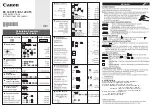
To avoid this, functions and programs should be defined with argument variable names that WILL NOT
be used as arguments during subsequent function or program calls. We suggest you avoid choosing
variable names like x,y,z,a,b,c,... for argument names when defining a function or program. These
common variable names are frequently used and could easily be included as an argument in a function
or program call. Instead, choose variable names like xx, xtemp, yy, ytemp, zz, ... for argument names
when defining a function or program. By doing this, you can then use x,y,z,a,b,c... when you call the
function or program. This minimizes any chance that you will call a function or program with an
argument name that could produce an unexpected result.
For example, on the home screen:
define f(xx)=ln(ln(xx)+xx)
(Done)
f(x+1) simplifies to ln(ln(x+1)+x+1)
(expected result)
One common area where the simplification problem can occur is in the study of composition of
functions. For example, simplifying f(g(x)) with defined functions f(x) and g(x) to see the composition of
"f composed on g". When the functions f(xx) and g(yy) are defined, the simplification of f(g(x)) will then
give expected results.
For example, on the home screen,
define f(xx)=xx^2
(Done)
define g(xtemp)=xtemp+1
(Done)
define h(yy)= yy^(1/2)+1
(Done)
f(g(x)) simplifies to (x+1)^2 (expected result)
h(f(x)) simplifies to abs(x)+1 (expected result)
If the arguments in a function or program call are not symbolic, then all simplification will work as
expected. Composition of functions is also commonly studied when graphing y2(y1(x)). Because the
graphing application on the TI-92 is completely numeric, all composition of functions in graphing work
as expected. However, the TI-92 graphing functions y1(x),y2(x),..., y99(x) enforce the use of x as the
argument variable name. Therefore, if these system graphing functions are used to study composition
of functions symbolically on the home screen, unexpected results can occur.
You can determine whether your version of the TI-92 includes the newer software by doing the
following:
On the home screen enter, define f(x)=x^2 (done). Then enter f(x+1). If you get an error "Circular
definition" then you have the newer software. If you get a simplified result of (x+1)^2, then you have the
older software.
Construct an ellipse in TI-92 Geometry.
!
Construct a circle.
!
Construct a point (A) on the circle. Construct a point (B) inside the circle.
!
Connect those points.
!
Construct the perpendicular bisector of the segment between points A and B.
From here you have two options to construct the ellipse.
!
Construct the locus of the bisector as point A moves on the circle -- the envelope of lines is the
ellipse. This means that the line we constructed is tangent to the ellipse. The point of tangency is
*not* the midpoint of the segment.
B - 12
Summary of Contents for TI-92+
Page 52: ...Component side of PCB GraphLink I O connector detail 1 41...
Page 53: ...LCD connector detail PCB switch side 1 42...
Page 54: ...Key pad sheet contact side Key pad sheet key side 1 43...
Page 55: ...Key cap detail 1 44...
Page 57: ...Component side of PCB with shield removed A detail view of the intergrated circuits 1 46...
Page 410: ...void extensionroutine2 void Credit to Bhuvanesh Bhatt 10 4...
















































